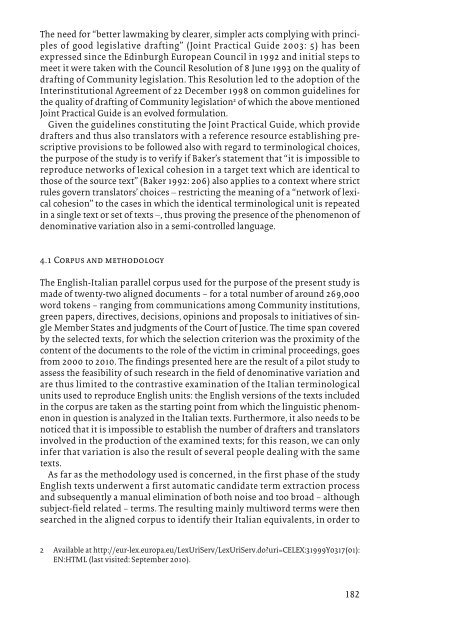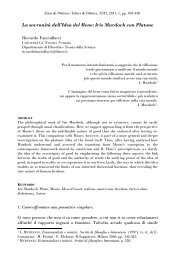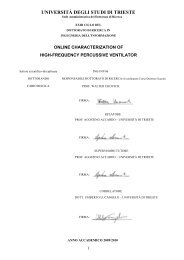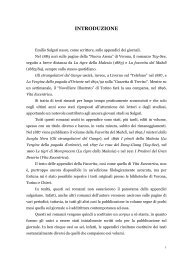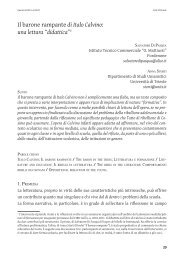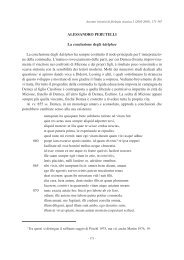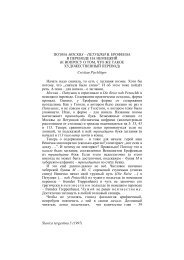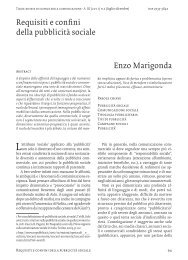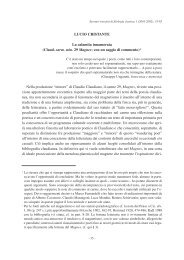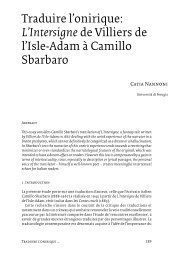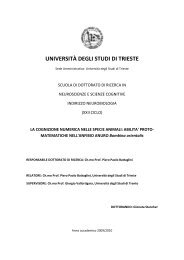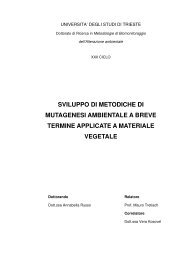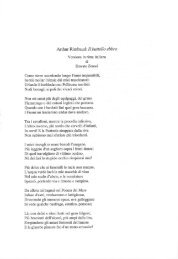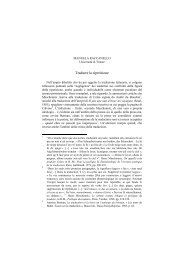Horizontal denominative variation in an EU victim ... - OpenstarTs
Horizontal denominative variation in an EU victim ... - OpenstarTs
Horizontal denominative variation in an EU victim ... - OpenstarTs
You also want an ePaper? Increase the reach of your titles
YUMPU automatically turns print PDFs into web optimized ePapers that Google loves.
The need for “better lawmak<strong>in</strong>g by clearer, simpler acts comply<strong>in</strong>g with pr<strong>in</strong>ciples<br />
of good legislative draft<strong>in</strong>g” (Jo<strong>in</strong>t Practical Guide 2003: 5) has been<br />
expressed s<strong>in</strong>ce the Ed<strong>in</strong>burgh Europe<strong>an</strong> Council <strong>in</strong> 1992 <strong>an</strong>d <strong>in</strong>itial steps to<br />
meet it were taken with the Council Resolution of 8 June 1993 on the quality of<br />
draft<strong>in</strong>g of Community legislation. This Resolution led to the adoption of the<br />
Inter<strong>in</strong>stitutional Agreement of 22 December 1998 on common guidel<strong>in</strong>es for<br />
the quality of draft<strong>in</strong>g of Community legislation 2 of which the above mentioned<br />
Jo<strong>in</strong>t Practical Guide is <strong>an</strong> evolved formulation.<br />
Given the guidel<strong>in</strong>es constitut<strong>in</strong>g the Jo<strong>in</strong>t Practical Guide, which provide<br />
drafters <strong>an</strong>d thus also tr<strong>an</strong>slators with a reference resource establish<strong>in</strong>g prescriptive<br />
provisions to be followed also with regard to term<strong>in</strong>ological choices,<br />
the purpose of the study is to verify if Baker’s statement that “it is impossible to<br />
reproduce networks of lexical cohesion <strong>in</strong> a target text which are identical to<br />
those of the source text” (Baker 1992: 206) also applies to a context where strict<br />
rules govern tr<strong>an</strong>slators’ choices ‒ restrict<strong>in</strong>g the me<strong>an</strong><strong>in</strong>g of a “network of lexical<br />
cohesion” to the cases <strong>in</strong> which the identical term<strong>in</strong>ological unit is repeated<br />
<strong>in</strong> a s<strong>in</strong>gle text or set of texts ‒, thus prov<strong>in</strong>g the presence of the phenomenon of<br />
<strong>denom<strong>in</strong>ative</strong> <strong>variation</strong> also <strong>in</strong> a semi-controlled l<strong>an</strong>guage.<br />
4.1 Corpus <strong>an</strong>d methodology<br />
The English-Itali<strong>an</strong> parallel corpus used for the purpose of the present study is<br />
made of twenty-two aligned documents – for a total number of around 269,000<br />
word tokens – r<strong>an</strong>g<strong>in</strong>g from communications among Community <strong>in</strong>stitutions,<br />
green papers, directives, decisions, op<strong>in</strong>ions <strong>an</strong>d proposals to <strong>in</strong>itiatives of s<strong>in</strong>gle<br />
Member States <strong>an</strong>d judgments of the Court of Justice. The time sp<strong>an</strong> covered<br />
by the selected texts, for which the selection criterion was the proximity of the<br />
content of the documents to the role of the <strong>victim</strong> <strong>in</strong> crim<strong>in</strong>al proceed<strong>in</strong>gs, goes<br />
from 2000 to 2010. The f<strong>in</strong>d<strong>in</strong>gs presented here are the result of a pilot study to<br />
assess the feasibility of such research <strong>in</strong> the field of <strong>denom<strong>in</strong>ative</strong> <strong>variation</strong> <strong>an</strong>d<br />
are thus limited to the contrastive exam<strong>in</strong>ation of the Itali<strong>an</strong> term<strong>in</strong>ological<br />
units used to reproduce English units: the English versions of the texts <strong>in</strong>cluded<br />
<strong>in</strong> the corpus are taken as the start<strong>in</strong>g po<strong>in</strong>t from which the l<strong>in</strong>guistic phenomenon<br />
<strong>in</strong> question is <strong>an</strong>alyzed <strong>in</strong> the Itali<strong>an</strong> texts. Furthermore, it also needs to be<br />
noticed that it is impossible to establish the number of drafters <strong>an</strong>d tr<strong>an</strong>slators<br />
<strong>in</strong>volved <strong>in</strong> the production of the exam<strong>in</strong>ed texts; for this reason, we c<strong>an</strong> only<br />
<strong>in</strong>fer that <strong>variation</strong> is also the result of several people deal<strong>in</strong>g with the same<br />
texts.<br />
As far as the methodology used is concerned, <strong>in</strong> the first phase of the study<br />
English texts underwent a first automatic c<strong>an</strong>didate term extraction process<br />
<strong>an</strong>d subsequently a m<strong>an</strong>ual elim<strong>in</strong>ation of both noise <strong>an</strong>d too broad – although<br />
subject-field related – terms. The result<strong>in</strong>g ma<strong>in</strong>ly multiword terms were then<br />
searched <strong>in</strong> the aligned corpus to identify their Itali<strong>an</strong> equivalents, <strong>in</strong> order to<br />
2 Available at http://eur-lex.europa.eu/LexUriServ/LexUriServ.do?uri=CELEX:31999Y0317(01):<br />
EN:HTML (last visited: September 2010).<br />
182


